Complete Solutions to EXERCISE of chapter MOTION IN ONE DIMENSION of Class 11 book with complete answers and questions
| Class 11 | PHYSICS |
| Chapter | MOTION IN ONE DIMENSION |
| MAXIMUM PUBLICATION | EXERCISE |
| Number Of Questions | 59 |
| Academic Year | 2023-24 |
Which of the following curves does not represent motion in one dimension?
View SolutionFree fall of an object(in vaccum) is a case of motion with
View SolutionThe area under velocity-time graph for a particle in a given interval of time represents
View SolutionA car travels half the distance with constant velocity of `40`kmph and the remaining half with a constant velocity `60`kmph.The average velocity of the car in `kmph` is
View SolutionThe acceleration of a moving object is equal to the
View SolutionA ball is thrown vertically upwards and comes back.Which of the following graph represents the velocity-time graph of the ball during its flight?
View SolutionThe magnitude of average velocity is equal to average speed.In which case this condition is staisfied?
View SolutionCan a body be said to be at rest as well as in motion at the same time?
View SolutionWhat conclusion can you draw if the average velocity is equal to instanteneous velocity?
View SolutionWhy the speed of the object can never be negative?
View SolutionIs it possible that the velocity of an object be in a direction other than the direction of acceleration?If yes,give an example.
View SolutionIs it possible to have the rate of change of velocity constant while the velocity itself changes both in magnitude and direction.If yes,give an example.
View SolutionIf the acceleration of the particle is constant in magnitude but not in direction,what type of path does the body follow?
View SolutionTwo stones of different sizes are dropped simultaneously from the top of a building.Which stone would reach earlier?Why?
View SolutionA piece of paper and iron piece are dropped simultaneously from the same point in vaccum.Which one will reach at ground earlier?
View SolutionIs it possible that your cycle has a southward velocity but northward acceleration?If yes,give an example.
View SolutionAn ant is moving through a graph paper along x-axis.A boy observes that the ant covers `1mm` in every second. What type of motion is this?
View SolutionSome examples of motion are given below.State in each case if the motion is one,two,or three dimension
a)A kite flying on a windy day.
b)A speeding car on a long straight highway.
c)A carrom coin rebounding from the side of the board.
d)A planet revolving around its star.
View SolutionTwo bodies start moving in the same straight line at the same instant of time from the same origin.The first body moves with a constant velocity of `40 m/s` and the second starts from rest with a constant acceleration of `4m/s^2`.
a)What is uniform speed?
b)Find the time that elapses before the second catches the first body.
View SolutionDisplacement is a vector quantity while distance is a scalar quantity.Distinguish between scalar and vector quantities.
View Solution"The aerial distance between two towers is `4km`.But speedometer of car shows `5.6km` when travel from one tower to another." By reading this statement explain the concept of distance and displacement.
View SolutionA stone is thrown upwards from the ground with a velocity,`u`.
a)What is the maximum height attained by the stone?
b)Check the correctness of the equation obtained in,(a)using the method of dimensional analysis.
c)Draw the position-time graph of the stone during its return journey
View SolutionGopal dropped an apple from the top his flat at a height of `10m`.He told his sister Seetha on the ground below that it will reach the ground in `2 sec` after he drops it. Can she catch it after `2sec`?
View SolutionA tow rope used to pull the car of mass `700kg` will break if the tension exceeds `1500N`.
a)Calculate the maximum acceleration with which the car can be pulled through a level road.
b)Calculate the minimum time required to bring the car to work station `500m` away from the break point.
View SolutionThe relative velocity of a body `A` with respect to a body `B` is the time rate at which body `A` changes its position with respect to body `B`.
a)If `V_A` and `V_B` are the velocities of `A` and `B` moving in opposite directions,what is the relative velocity of `A` with respect to `B`?
b)Two trains along the same straight rails are moving with constant velocity of `60km/h` and `30km/h` towards each other.If at time `t=0`,the distance between them is `90km`,find the time when they collide.
c)The velocity time graph of two bodies `A` and `B` make angles of `30°` and `60°` with the time axis,what is the ratio of their acceleration?
View SolutionA balloon is ascending at the rate of `14ms^(-1)` and at a height of `98m` above the ground, a stone is dropped from it.
a)State whether the motion of the balloon is accelerated or retarded?
b)After how much time does the stone reach the ground?
c)Determine the velocity with which the stone strikes the ground.
View SolutionA particle is moving along `x`-axis with a uniform positive acceleration.Draw the position time graph for its motion.
View SolutionState the difference between speed and velocity.Can a body move with uniform speed but with variable velocity?Explain with the help of an example.
View SolutionA sprinter starts from rest and pickup a speed of `12m/s` in `3seconds`.
a)Name the type of motion.
b)Derive a relation to find distance travelled during `t` second for this type of motion.
c)A car manufacturer advertises that the brakes are so perfect that the car stops instantly.Do you agree?Explain.
View Solutiona)Acceleration due to gravity is `9.8m/s^2`.What is meant by the value of `9.8`?
b)Obtain a relation between velocity-position of a uniformly accelerated body.
c)A particle moving with a certain velocity is subjected to a retardation of `4m/s^2`,if it returns to the starting point in `12s`.Calculate the initial velocity.
View SolutionIn which of the following examples of motion, can the body be considered approximately a point object:
View SolutionA car moving along a straight highway with speed of 126 km `h^-1` is brought to a stop within a distance of 200 m. What is the retardation of the car (assumed uniform), and how long does it take for the car to stop?
View SolutionOn a two lane road, car A is travelling with a speed of 36 km h −1 . two cars B and C approach car A in opposite directions with a speed of 54 km h −1 each. At a certain instant, when the distance AB is equal to AC, both being 1 km, B decides to overtake A before C does. What minimum acceleration of car B is required to avoid an accident?
View SolutionRead each statement below carefully and state with reasons and examples, if it is true or false, A particle in one-dimensional motion:
a) with zero speed at an instant may have non-zero acceleration at that instant,
b)with zero speed may have non-zero velocity,
c)with constant speed must have zero acceleration,
d)with positive value of acceleration must be speed-ing up.
View SolutionA man walks on a straight road from his home to a market `2.5 km` away with a speed of ` 5 km h^(-1)`. Finding the market closed, he instantly turns and walks back home with a speed of `7.5km h^(-1)`.
a) What is the magnitude of average velocity, and
b) average speed of the man over the following intervals of time:
i)`0 to 30` min, ii)` 0 to 50` min, iii)` 0 to 40 `min ?
View SolutionLook at the graphs (a) to (d) in the following figure carefully and state, with reasons, which of these cannot possibly represent one-dimensional motion of the particle.

View SolutionIf 'v' is the velocity and 'a' is the acceleration , give an example of a physical situation for each of the following cases.
(a) `v != 0`, `a = 0`
(b) `v = 0`, `a != 0`
(c) `v > 0`, `a < 0`
(d) `v < 0`, `a > 0`
View Solution(a) The figure shows the position time graph of a body moving along a straight line.
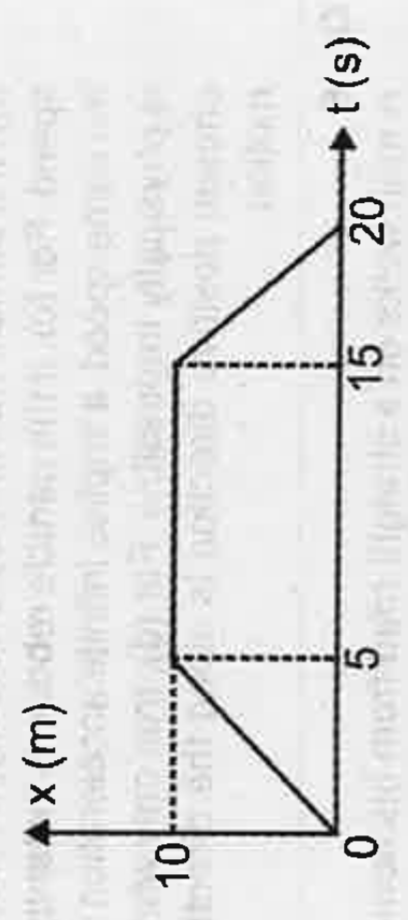
i) Draw the velocity - time graph of the body.
View SolutionThe figure shows the position time graph of `a` body moving along a straight line.
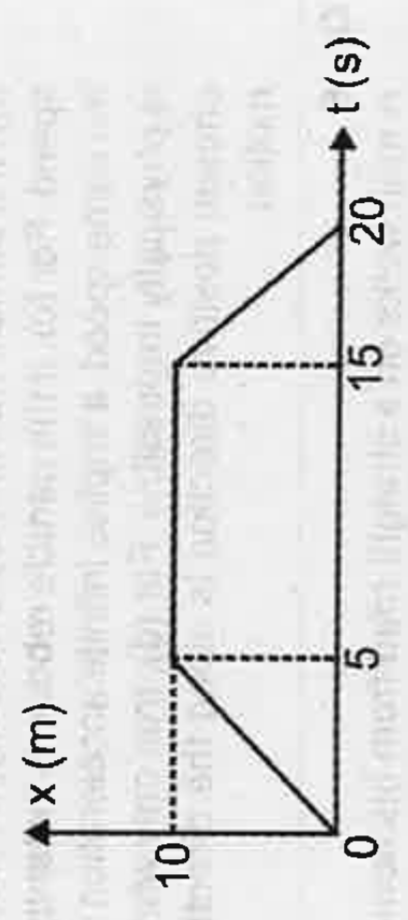
ii) From the graph, find the displacement in `20` seconds.
View SolutionFrom the velocity-time graph of a body moving with uniform acceleration, deduce the velocity-time relation and the velocity-displacement relation.
View SolutionA physical quantity having both magnitude and direction is a vector and if it has only magnitude it is a scalar. Categorize the following physical quantities into scalars and vectors.
(a) Force
(b) Angular momentum
(c) Time
(d) Work
View SolutionAcceleration is the time rate of change of velocity.
Give an example of a body possessing zero velocity and still accelerating.
View SolutionGraph representing the motion of a body is shown below. State with reason whether it can represent one dimensional motion.

View SolutionGraph representing the motion of a body is shown below. State with reason whether it can represent one dimensional motion.
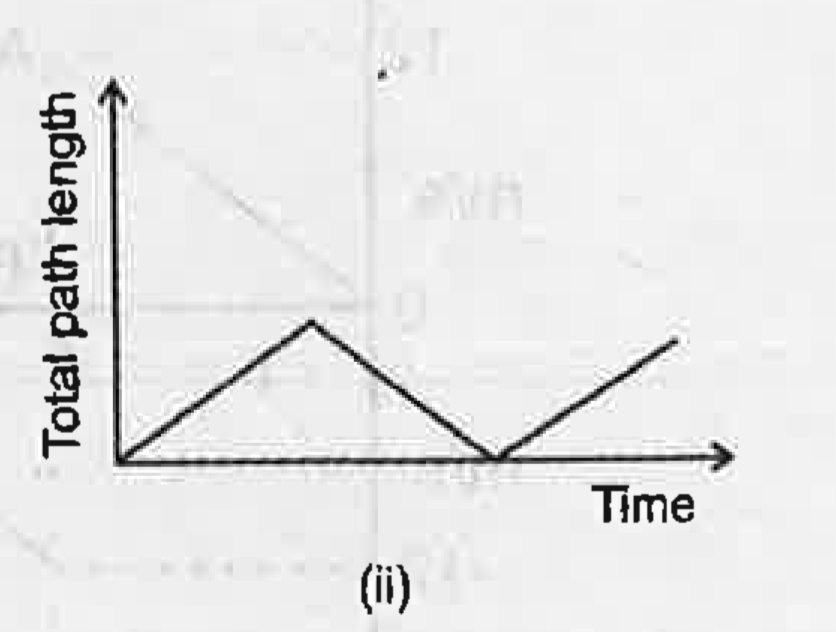
View SolutionAcceleration -time graph of a body starts from rest as shown below :
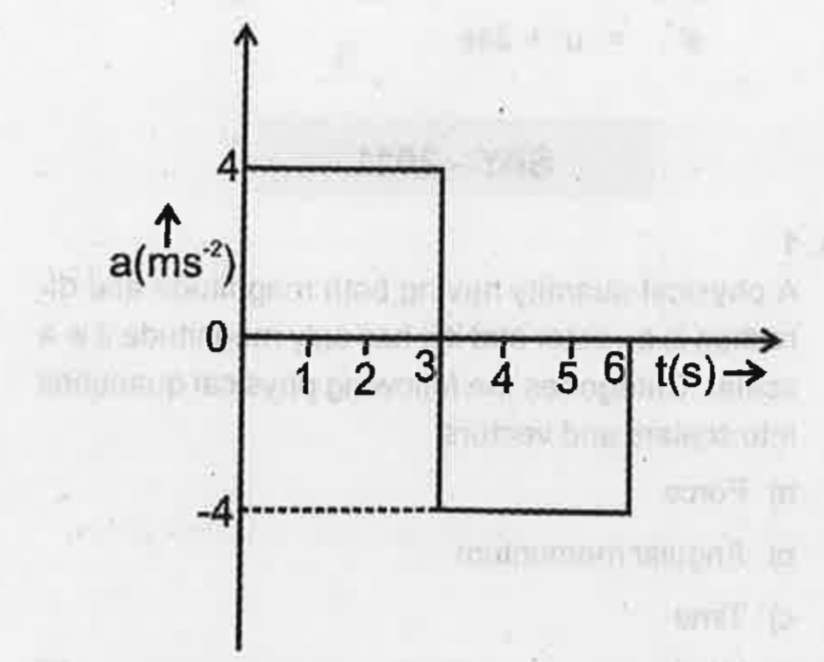
What is the use of the acceleration - time graph?
View SolutionAcceleration -time graph of a body starts from rest as shown below :
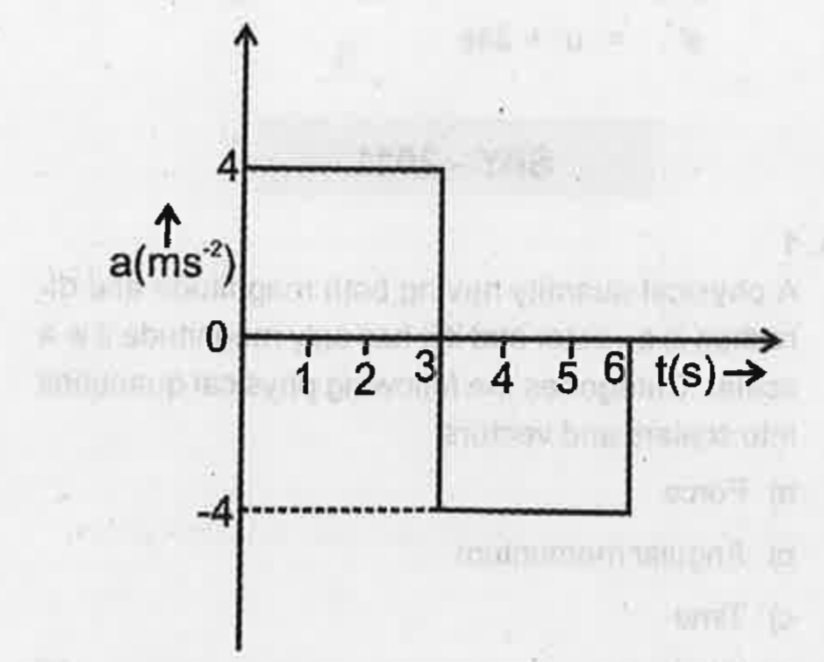
Draw the velocity-time graph using the above graph
View SolutionAcceleration -time graph of a body starts from rest as shown below :
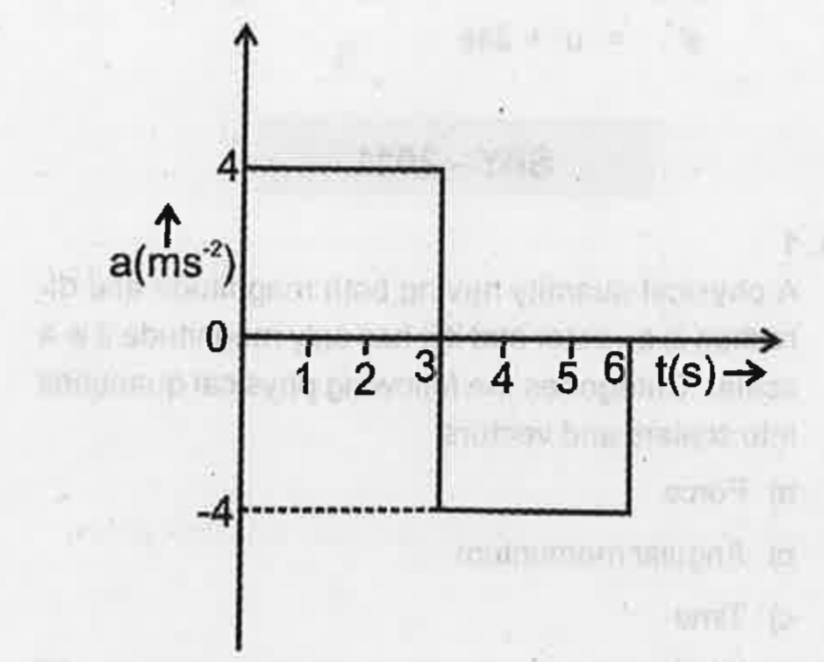
Find the displacement in the given interval of time form 0 to 3 seconds.
View SolutionState in the following cases whether the motion is one,two or three dimensions.
(i) A butterfly flying around a flower.
(ii) A bus moving along a long and straight road.
View SolutionDerive the equations of motion for non-uniform motion in one dimension.
View SolutionAcceleration is defined as the rate of change of velocity.
Is it possible for a body to have acceleration without velocity?Explain.
View SolutionAcceleration is defined as the rate of change of velocity.
Draw the velocity-time graph of a body moving with uniform acceleration `a` and initial velocity `v_0`.
View SolutionAcceleration is defined as the rate of change of velocity. Obtain the equation for displacement in time `t`.
View SolutionVelocity is defined as the rate of change of displacement.
Distinguish between average velocity and instantaneous velocity.
View SolutionVelocity is defined as the rate of change of displacement.
When does the average velocity become equal to the instantaneous velocity?
View SolutionVelocity is defined as the rate of change of displacement.
A car travels from `A` to `B` at `60km/hr` and returns to `A` at `90km/hr`.What is its average velocity and average speed?
View SolutionThe ratio of velocity,to speed of an object is __________
(i)one
(ii)greater than one
(iii)less than one
(iv)either less than one or equal to one.
View SolutionA stone is dropped from height h. Arrive at an expression for the time taken to reach the ground.
View SolutionAn object released near the surface of the earth is said to be in free fall.(Neglect the air resistance).
Choose the correct alternative from the clues given at the end of the statement.
"Free fall is an example of __________ accelerated motion."(uniformly/nonuniformly).
View SolutionArea under velocity-time graph gives __________.
View Solution
EXERCISE questions and complete solutions for chapter MOTION IN ONE DIMENSION of MAXIMUM PUBLICATION of Class 11